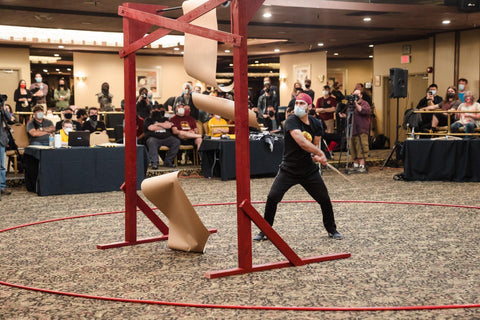How to cut paper with a sword
During the pandemic, the HEMA community lost our main source of tatami mats for sword cutting. With tatami being the primary cutting medium used in HEMA cutting competitions, the lack of available, cheap tatami mats meant we had to find new viable options for sword cutting targets.
Enter paper. After weeks of experimentation (and many feet of paper), RJ McKeehan, owner of SoCal Swords and winner of many cutting competitions, and Sean Franklin, founder of Sword STEM, determined the paper type and configuration that could best challenge even experienced HEMA cutters while accurately gauging their technique.
They introduced paper as a primary target for the beginning, open, and advanced cutting tournaments at SoCal Swordfight 2022 (run by SoCal Swords). Feats included unterhaus, double cuts, and tatami concealed behind a length of paper (competitors had to cut through both successfully).  The new medium received overwhelmingly positive feedback from competitors at all levels and is likely to remain a staple in future cutting tournaments.
The new medium received overwhelmingly positive feedback from competitors at all levels and is likely to remain a staple in future cutting tournaments.
So, how can you get started cutting paper? Below we explain the benefits of paper, the type of paper to buy, how to set it up, techniques to keep in mind when cutting paper, and how to read the feedback from your cuts.
Why should you cut paper?
There are many things to cut with a sword, each with their own pros and cons. Check out our comparison of several common sword cutting materials if you’re still deciding on a cutting medium.
Or just take our word for it here: Paper can be a great way to practice cutting, especially if you’re looking for a water bottle or tatami mat cutting alternative.
Paper sounds easy to cut, and at its core, it is. However, its flimsiness also works against the cutter. Without maintaining good form throughout your cut, you’re likely to rip the paper, push it to the side, or potentially not cut it at all.
It’s not a perfect cutting material, though. You can get away with cutting paper at slow speeds as long as you use correct form. You’ll need to raise your speed to succeed at cutting other objects, like tatami or clay.
If paper seems too simple, you can always increase the challenge by using a blunt rather than a sharp sword. This requires speed and good alignment, making paper a suitable target for all levels of sword cutting. It also makes it accessible for those who don’t have their own sharp sword.
Best of all, paper is relatively inexpensive, you’ll get hundreds of cuts from a single roll, and there’s no need to clean your blade after cutting it. It’s also both reusable and recyclable, with the paper we sell for cutting already being 100% recycled. At SoCal Swords, we reuse cut paper again as packing material–so you can be sure that any crumpled paper in a package from us was cut by a sword!
What paper should you buy for sword cutting?
Paper is everywhere, but only certain types are effective for sword cutting. Look for a thick, heavy duty roll that’s wide enough to provide a challenge and to give you feedback throughout the length of your cut.
We recommend 75 lb craft paper at least 2 feet in width.
We’ve found that other paper is too flimsy to provide a meaningful target. Besides being too easy to cut, thin paper may rip too easily from slight cutting errors. Rather than showing the deviation of your cut (scalloping) or roughness along the edge, it will simply rip in two.
Building a cutting stand for paper
Paper is a bit different from other cutting mediums because, rather than being placed on a sword cutting stand, it must be suspended from above. There are two main ways to do this:
-
Build a custom stand: We built a paper cutting stand for SoCal Swordfight when the venue had no place to suspend the paper rolls. The paper sat on a tube between two tall pieces of wood that formed a support structure. The stand was time intensive to build, difficult to transport, and complicated to set up and break down, so we don’t recommend using one unless you have no other option (and hopefully an engineering background).

-
Hang it from a rope: The easiest way to cut paper is by threading a rope through the center of the paper roll and securing each end to a ceiling beam, tree branch, or similar structure. If you use this method, make sure that the beam or branch is above your head level and that it’s clear of all other obstacles so you don’t hit anything other than the paper when swinging your sword.

Keep in mind that wind can play a huge role in your ability to cut paper. In general, we recommend cutting indoors if possible (if you do, consider placing a piece of plywood beneath your cutting area to protect your floors).  Alternatively, you can clamp weights to the bottom of the hanging piece of paper to help stabilize it.
Alternatively, you can clamp weights to the bottom of the hanging piece of paper to help stabilize it.
Once the paper is suspended, pull down on the end of the roll until it reaches ground level or just above. Make your cut, then pull on the end of the roll again to reset.
An efficient cut should use the smallest amount of paper possible, up to about one foot. Alternating directions when cutting will use more paper, reducing the number of cuts you can get from a roll.
How to cut paper with a sword
Paper is relatively easy to cut (check out our sword cutting targets comparison article to see how it stacks up against water bottles, tatami, and clay). That doesn’t mean you’ll make perfect cuts every time. Here are a few things to keep in mind:
- Find still air or use weights: Make sure there’s no wind that could blow your paper around. This will make it very difficult, if not impossible, to cut consistently. If you have no choice but to cut paper outdoors on a breezy day, attach a weight the end of the roll to keep the paper straight and still.
- Align the paper: If the edge of the paper is curled away from you, it’ll be much easier to tear or to bat away with your sword. Make sure the edge of the paper is straight and still to help you cut it. If a curl is present, aim it toward you rather than away. The sword needs to “bite” into the edge of the paper to begin a good cut.
- Practice good form: You don’t need much speed to cut paper, but you do need excellent form. Keep your wrists straight (unbroken) throughout your swing, generate power with your hips, and follow through on your cut by twisting your hips. Once you’re consistently making good cuts at slower speeds, start swinging with more and more velocity to practice for harder targets such as tatami. We plan to write future posts on cutting mechanics, but an excellent place to start is the book Cutting with the Medieval Sword by Michael Edelson.
-
Adjust based on feedback: Paper gives a lot of feedback on your cutting technique (see next section). Taking the time to understand and immediately adjust your technique based on this feedback is key to improving your cutting skills.
- Change the difficulty level: If you’re having a hard time cutting paper, try weighting the ends. If it’s too easy, switch to using a blunt sword, which will require more speed and perfect form to achieve successful cuts. Additionally, descending cuts are significantly easier than ascending cuts. Vary your angles and try to perfect them all!
Feedback from cutting paper
Paper can give you great feedback on your cutting technique because its width shows your performance through a long section of your cut. On the other hand, water bottles and tatami [link to comparison again] are narrower and give direct feedback only on a small portion of your swing.
Look for a long, straight line with no rips, waves, or jagged edges.  The cut piece should have fully separated from the roll. Ripping the paper at the beginning of your cut indicates poor edge alignment, possibly caused by rotating your hands or moving your hands horizontally instead of along your cut line.
The cut piece should have fully separated from the roll. Ripping the paper at the beginning of your cut indicates poor edge alignment, possibly caused by rotating your hands or moving your hands horizontally instead of along your cut line.  A wavy line or jagged edges through the paper suggests rotation in your hands during the cut, or potentially that you moved your body during the course of the cut (for example, straightening your knees and rising up).
A wavy line or jagged edges through the paper suggests rotation in your hands during the cut, or potentially that you moved your body during the course of the cut (for example, straightening your knees and rising up).
After your cut, you want the top hanging piece of paper to show minimal movement. If the paper is waving back and forth, it indicates a flaw, such as a slight twist in your hands, to your cut. Performing a perfect cut that keeps the paper as still as possible also prepares you to immediately follow up with a second cut (such as a double cut), which will be easier to achieve if the paper is unmoving.
Is paper good for cutting with swords?
Overall, yes. We appreciate the versatility of paper, its affordability, its environmental friendliness, and its ease of use. While paper has its downsides, namely allowing slower cuts to succeed, it’s a great tatami mat cutting alternative. Try cutting paper (we sell paper rolls at SoCal Swords) and let us know what you think!
